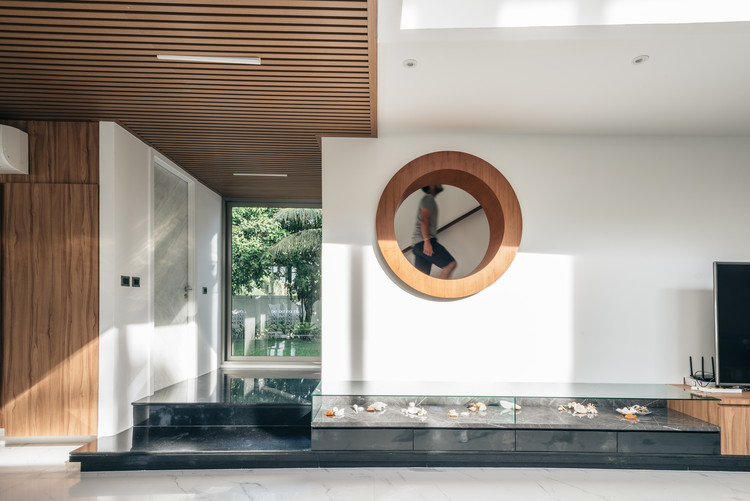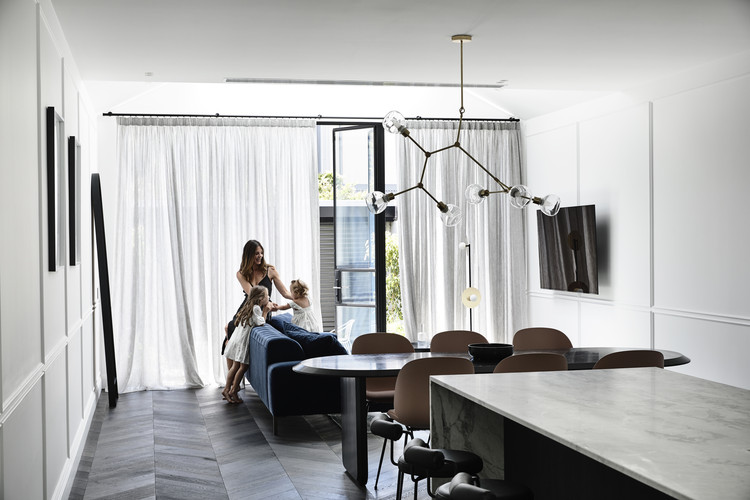Visegad Town Center aplusarchitects + S73 stúdió
2015-05-18 03:00
架构师提供的文本描述。Visegrád有1800名居民,被认为是匈牙利最小的城镇。市中心的发展是一个很好的例子,说明由于经济危机-除了其负面影响-原来夸大的想法如何被改变,并促进了可持续发展的诞生,满足了当地社区的持续需求和旅游业的暂时需求。
Text description provided by the architects. Visegrád, with its 1800 inhabitants, is considered to be the smallest town of Hungary. The development of the town center is a fine example for how the original exaggerating ideas were altered due to the economic crisis – besides its negative effects – and facilitated the birth of a sustainable development, satisfying the continuous needs of the local community and the temporary demands of tourism.
Visegrád是一个有着千年历史的聚居地,以前被用作皇家居住地,但就其规模和建筑而言,如今的这座城镇相当简陋。2000年,在获得该镇地位后,与其规模相比,该定居点承担了一项具有里程碑意义的任务。在这个被认为是中世纪城镇主广场的地方,人们提出了一项计划,要建造一个新的城镇中心。2008年,作为上述竞赛的获胜者,Anna Mária Tamás和Krisztián Kovács-Andor(建筑师)开始设计城镇中心、市政厅、沙龙、文化中心、一个新的主广场和其他公共空间。然而,在接下来的几年里,经济危机的出现掩盖了最初的想法,需要修改设计方案。考虑到可持续性和成本效益,城镇中心的发展走上了一个新的方向.我们完全重新定义了设计方案,重点是对现有和闲置建筑的利用。此外,现代化、翻新和扩建是新建筑数量少的主要问题。唯一全新的元素是活动厅。
Visegrád is a thousand-year-old settlement, formerly used as royal residency, however the town today is rather rustic in terms of its scale and buildings. In 2000, after acquiring the town status, the settlement undertook a monumental mission, compared to its size. At the place of the supposed medieval town’s main square, a plan was put out to competition to build a new town center. In 2008, as the winners of the previously mentioned competition, Anna Mária Tamás and Krisztián Kovács-Andor (aplusarchitects) began to design the town center, town hall, saloon, cultural center, a new main square and other public spaces. However, in the next few years the emergence of the economic crisis overwrote the original ideas and required the revision of the design program. Considering sustainability and cost-effectiveness the development of the town center took a new direction. We completely redefined the design program, which put the emphasis on the utilization of the existing and idle buildings. Moreover modernization, refurbishment and expansion were major concerns with a low number of new constructions. The only entirely new element is the events hall.
活动大厅可以在最初设计的市政厅所在地找到,位于中世纪德国城镇主广场的正面。它的作用,一方面是为市中心提供一个面向多瑙河的大门,另一方面它创造了大事件广场和小事件广场之间的联系。这座建筑可以分为叶片墙,它的“消失”的大门,它能够服务于一个和另一个,万一发生重大事件,两者。它的活动广场-开放或关闭-适合组织展览,演示,招待会和工艺市场。
The events hall can be found at the place of the town hall, designed originally, in the façade of the medieval German town’s main square. Its role, on the one hand is to provide a face for the town center with being a gate towards the Danube, on the other hand it creates connection between the big and the small events squares. The building can be opened into blade walls, with its ‘disappearing’ gates it is able to serve one and the other, in case of grand events, both. Its events square – open or closed – is suitable for organizing exhibitions, presentations, receptions and craft markets.
“健康屋”外墙的镶板式扩建,是在主街俯瞰多瑙河的华丽木屋的当代抄本。它的实际功能是一个室外盖着露天盖地的阁楼梯,但它的主要作用是形成面向活动广场和多瑙河的健康之家的正面。
The paneling expansion of the Health-house’s façade is the contemporary transcript of the ornate wooden pediments of the houses in the Main Street overlooking the Danube. Its actual function is an outdoor covered-open loft ladder, however its main role is to form the facade of the Health-house towards the events square and the Danube.
公共空间的翻新是根据该镇当前和实际的需要进行调整的。作为公共空间计划的一部分,健康之家的院子已经形成,在周末被用作生物市场。活动大楼和健康之家之间的小活动广场适合组织小城镇项目,这是一个与小城镇大小相一致的公共广场。面对多瑙河的更大的草地空间,在举世闻名的宫廷运动会上生机勃勃。
The refurbishment of the public spaces is adjusted to the current and real needs of the town. As part of the public spaces program, the yard of the Health-house was formed, which is used as a bio market at the weekends. The smaller events square between the events buildings and the Health-house is suitable for organizing minor town programs, a public square calibrated to the size of a small town. The bigger grassy space, facing the Danube, comes alive at the time of the internationally-known Palace Games.
由于复杂的情况,这座建筑的形成不是作为一个新的,房子一样的城镇元素,而是一个物体一样的姿态,完整的景观。结构和材料的选择,内外空间的定义,以及它们之间的联系被认为是它的两个工具。外部空间和内部空间之间的联系是通过门窗以一种非传统的方式产生的。建筑物上的洞口为房屋的物体状态服务。这座建筑主要是一个临时空间。一方面,它是一个盖开的棚屋,作为一个门的主题,另一方面,它是一个事件广场,能够与其他空间不同地打开和关闭。
Due to the complex situation, the building was formed not as a new, house-like element of the town, but rather an object-like gesture of the complete landscape. The choice of structure and materials, the definition of the interior and exterior spaces, and the connections among all these were considered as its two tools. The connection between the exterior and interior spaces comes into being in a non-traditional way, by means of windows and doors. The openings on the building serve the object-like state of the house. The building is mainly a temporary space. On the one hand it is a covered-opened shed functioning as a gate-motif, on the other hand it is an events square being able to be differentially open and closed with the other spaces.
Provisionality and sustainability
建筑物的功能是作为一个次级外观,作为一个膜,在某些情况下,它是可转换的。为了获得这种质量,选择木材作为主要的结构和覆盖材料。木材具有这些特征,这意味着问题的解决。天然的、局部的和传统的建筑材料,这些材料也会老化,而且是可以改变的,如果有必要的话,可以“消除”,不会有任何问题。就可持续性而言,它也是与整个建筑生命周期相关的一个很好的选择。
The building functions as a secondary façade, as a membrane, and in certain cases it is transformable. In order to have this quality, wood was chosen as a primary structural and covering material. Wood possesses the features, which meant solution for the problems arose. Natural, local and traditional building material, which also ages fairly and it is alterable, if necessary it can be ‘eliminated’ without any problem. In terms of sustainability, it is also a fine choice in connection with the entire lifecycle of the building.
除前面提到的情况外,可持续性意味着也可供当地社区的工匠使用的技术。这座大楼配备了单独设计和当地制造的家具。这是形成空间的一个关键方面,这些空间可以被不断变化的社区以不同的方式使用,并且通过改变需求,它可以很容易地被改变。还必须尽量减少需求和空间,并利用最少的空间和材料创造功能。
Beyond the previously mentioned, sustainability meant technologies that can be available also for craftsmen being present in the local community. The building was furnished with individually designed and locally made furniture. It was a crucial aspect to form spaces that can be used in a differentiated way by the constantly changing community and by means of changing the needs it can easily be transformable. It was also essential to minimize demands and spaces and create functions with using the minimum amount of space and materials.
Local communities – tourists
在Visegrád,有一个具有强烈身份的活跃社区,在那里,由于定居点的规模,参与比较容易,而且在设计方案的变化中也可以观察到。另一方面,目标观众更多的是由匈牙利和外国游客组成的一层。这座建筑渴望满足居民的日常需求,同时,它也能在临时项目中为广大人群提供服务。该项目被提名为2015年Mies van der Rohe奖的15个匈牙利项目之一。
In Visegrád there is an active community with strong identity, where participation is easier due to the scale of the settlement, and it can also be observed in the change of the design program. On the other hand, the target audience is an even more considerable layer consists of Hungarian and foreign tourists. The building is eager to satisfy the everyday needs of the inhabitants and in tandem with that, it is able to serve vast crowds at temporary programs as well. The project was nominated among the 15 hungarian project to the Mies van der Rohe Award 2015.
 举报
举报
别默默的看了,快登录帮我评论一下吧!:)
注册
登录
更多评论
相关文章
-

描边风设计中,最容易犯的8种问题分析
2018年走过了四分之一,LOGO设计趋势也清晰了LOGO设计
-

描边风设计中,最容易犯的8种问题分析
2018年走过了四分之一,LOGO设计趋势也清晰了LOGO设计
-

描边风设计中,最容易犯的8种问题分析
2018年走过了四分之一,LOGO设计趋势也清晰了LOGO设计










































































